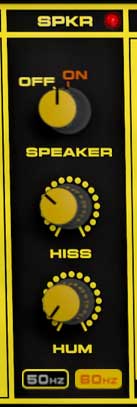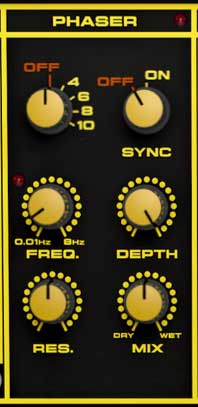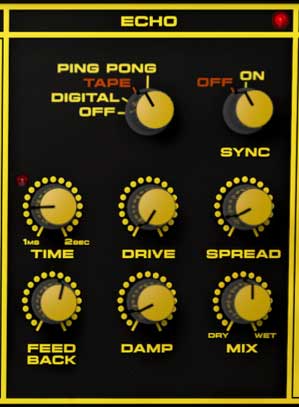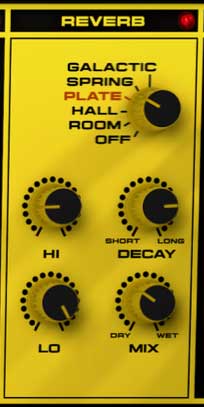
Yellowjacket includes five simultaneous effects: Speaker, Octafuzz, Phaser, Flanger/Chorus, Echo, and Reverb. These can be used in any combination. Additionally, it includes a global FX Out section with a unique stereo expander function.
Speaker
Yellowjacket includes a speaker effect that emulates the original instrument's onboard speaker, a feature that made the Wasp even more cost-effective back in the day. The speaker simulation gives Yellowjacket a decidedly lo-fi tone and changes the signal to mono. However, any stereo effects after the Speaker effect will add additional stereo width to the signal. If you load a preset and unexpectedly hear some hiss and hum, the mic image at the top of the interface indicates you have this effect on.

Speaker- Enables and disables the speaker effect. The LED next to SPKR name illuminates when the it's active.
Hiss- Amount of background noise in signal.
Hum, 50/60 Hz selecter- Amount of mains hum in signal. The hum frequency is selectable with the 50Hz and 60Hz buttons below. These correspond to the mains hum in England and US.
Note that Hiss and Hum are heard constantly, not just when notes are playing.
Octafuzz
A multimode overdrive/distortion effect with built-in octaver. The LED next to OCTAFUZZ name illuminates when the it's active.

Mode control-
Off- Distortion effect is disabled,
Tube- Tube overdrive tone.
Fuzz- Aggressive, hairy fuzztone emulation.
Saturation- Plenty of gain here, but high frequencies are more intact.
Clean- Distortion is disabled, but Octave, Tone, and Mix controls are still active.
Octave- Adds a square wave either one octave down when knob is turned counterclockwise from center, or two octaves down when knob is turned clockwise from center.
Drive- Sets the amount of distortion/fuzz.
Tone- Tilt EQ; turning the knob counterclockwise from center position increases bass, turning clockwise from center position increases treble.
Mix- Sets Octafuzz wet/dry ratio.
Make-up Gain- This guy's hiding in the lower section of Octafuzz. The idea here is that different Drive settings can radically affect the overall sound level. Make-Up Gain acts as something of a "master volume" to make it easier to match input and output levels.
Phaser
Phase shifter effect with up to 10 stages. The LED next to PHASER name illuminates when the it's active.

Mode control-
Off- Phaser effect is disabled.
4/6/8/10 Stage setting- Yellowjacket's phaser includes up to 10 all-pass filter stages. As a general rule, more stages = lusher phase, but there are plenty of interesting tones to be had using the lower stage settings.
Sync- The Sync control locks the rate of the Phaser's modulation LFO to the tempo in the top toolbar when using the Yellowjacket standalone version, or to the current project tempo when the plug-in version is used in a DAW. When engaged, the Speed knob snaps to note values ranging from 1/64th note triplet to 8 beats.
Freq.- Sets the phaser's internal LFO speed from 0.01 to 8 Hz.
Depth- Sets the effect depth - essentially an amount control.
Res.- Increasing the amount of Resonance intensifies the phasing effect. This is sometimes referred as "feedback" in other phasor units.
Mix- Sets Phaser wet/dry ratio. Typically you'd want this at 50/50 for classic phasing effects.
Flange/Chorus
We've included a thick and warm flange/chorus effect. Flanging and Chorus are closely related - the general difference being that flangers use a shorter time range and some amount of feedback (this intensifies the "jet-flyby" whoosh), whereas choruses utilize a slightly longer delay time, and no feedback. The LED next to FLANGER/CHORUS name illuminates when the it's active.

Mode control-
Off- Flange/Chorus effect is disabled.
Flanger- Flange mode is enabled.
Chorus- Chorus mode is enabled. Note that the Resonance knob is disabled when in Chorus mode.
Sync- The Sync slide switch locks the rate of the Flange/Chorus's modulation LFO to the tempo in the top toolbar when using the Yellowjacket standalone version, or to the current project tempo when the plug-in version is used in a DAW. When engaged, the Speed knob snaps to note values ranging from 1/64th note triplet to 8 beats.
Freq.- Sets the flanger/chorus internal LFO speed from 0.01 to 8 Hz.
Depth- Sets effect depth, i.e. the amount of modulation.
Res- Sets the amount of internal feedback when in Flange mode. Higher values result in a more intense flange sound.
Modulation Waves- Selects the shape of the modulation waveform. Options include sine, triangle, sawtooth, and ramp.
Mix- Sets the ratio of clean to effected sound. Flanging and chorusing is usually optimal at a 50/50 setting, but we've added the Mix control by popular demand to allow more subtle (or warble-riffic) tones.
Echo

Yellowjacket's Echo includes digital, tape, and ping-pong, plus cool modulation section. The LED next to ECHO name illuminates when the it's active.
Mode buttons-
Off- Disables Echo effect.
Digital- A pristine sounding digital delay.
Tape- Reproduces the effect of a vintage "space echo" tape delay.
Ping Pong- Echoes alternate between audio channels.
Sync- The Sync control locks the delay time to master tempo. When engaged, the Time knob snaps to note values ranging from 1/64th note triplet to 8 beats. Sync mode locks to the tempo in the top toolbar when using the Yellowjacket standalone version or the current project tempo when the plug-in version is used in a DAW.
Time- Sets delay time, from 1 to 2000 ms. If the Sync button is enabled, time settings snap to synchronized note values.
Drive- Adds subtle overdrive to the delayed signal for a more vintage sound. Keep in mind that the Tape algorithm adds a fair amount of its own drive-y mojo.
Spread- Alters the left and right channel delay times creating a stereoizing effect. Greater amounts of spread increase the delay time differential and thus the stereo separation.
Feed Back- Routes the output to the input for additional repeats. Be careful at high settings as this can result in runaway feedback madness.
Damp- Attenuates high-frequencies as the knob amount is increased. Not only does this create more natural sounding decays, it also reduces the "stacking" effect that occurs with high feedback levels.
Mix- Sets the ratio of clean to effected sound.
Reverb
Cherry Audio's awesome reverb effects, including super-big Galactic mode. The LED next to REVERB name illuminates when the it's active.

Mode buttons-
Off- Disables Reverb effect.
Room- Recreates a vintage algorithmic-style medium room verb.
Hall- A large, hall-style reverb.
Plate- A medium-to-large studio plate-style algorithm.
Spring- Recreates mechanical spring-reverb effect often seen (and kicked) in vintage guitar amps.
Galactic- Cherry Audio's exclusive, giant, spacey reverb.
Hi- A highpass filter affecting wet reverb signal only. Low frequencies are increasingly attenuated as the knob setting is increased.
Decay- Sets the length of reverb release time/size of room.
Lo- A lowpass filter affecting wet reverb signal only High frequencies are increasingly attenuated as the knob setting is decreased.
Mix- Sets the ratio of clean to effected sound.
FX Out
This acts as a master control section for effects and includes an awesome stereo expand function.

Global- Allows all effects (including the Speaker effect) to be bypassed.
Level- Sets an overall level for Octafuzz, Phaser, Chorus/Flanger, Echo, and Reverb. The dry signal and Speaker effect are not affected.
Stereo Expand- This widens the stereo image for dry and effected signals when the FX Out Global control is set to On. At minimum setting, stereo expansion is disabled. Note that voice pan positions are retained.